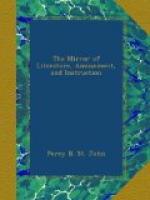Why is quartz the constituent of so many gems?
Because the tinges it receives from metals are sufficient to produce these varieties. Thus, amethyst, or purple quartz, is tinged with a little iron and manganese. Rose quartz, or false ruby, derives its colour from manganese. Avanturine is a beautiful variety of quartz, of a rich brown colour, which, from a peculiarity of texture, appears filled with bright spangles. Small crystals of quartz, tinged with iron, are found in Spain, and have been termed hyacinths of Compostella. Flint, chalcedony, carnelian, onyx, sardonyx, and bloodstone, or heliotrope, and the numerous varieties of agates, are principally composed of quartz, with various tinging materials.
Why is opal among the most beautiful productions of the mineral world?
Because the colours are not occasioned by any particular tinge of the substance, but by its peculiar property of refracting the solar rays. It is a compound of about 90 silica, and 10 water. The finest specimens come exclusively from Hungary. There is a variety of opal called Hydrophane, which is white and opaque till immersed in water; it then resembles the former.
Why is the sapphire genus so highly prized?
Because, after diamond, it is the hardest substance in nature. It forms also the most valuable gems, as the oriental ruby and the topaz. The blue variety, or sapphire, is harder than the ruby. It is infusible before the blowpipe. It becomes electrical by rubbing, and retains its electricity for several hours; but does not become electrical by heating. It occurs in alluvial soil, in the vicinity of rocks belonging to the secondary or floetz-trap formation, and imbedded in gneiss. It is found at Rodsedlitz and Treblitz in Bohemia, and Hohenstein in Saxony; Expailly in France; and particularly beautiful in the Capelau mountains, twelve days from Sirian, a city of Pegu. Next to diamond it is the most valuable of gems. The white and pale blue varieties, by exposure to heat become snow-white; and when cut, exhibit so high a degree of lustre, that they are used in place of diamond. The most highly prized varieties are the crimson and carmine red; these are the oriental ruby of the jeweller; the next is sapphire; and the last is sapphire, or oriental topaz. The asterias, or star-stone, is a very beautiful variety, in which the colour is generally of a reddish violet, with an opalescent lustre. A sapphire of ten carats weight is considered to be worth fifty guineas.—Jameson.
The blue topaz, or Brazilian sapphire, is of recent introduction. The white topaz considerably exceeds rock crystal in lustre, and in Brazil is called mina nova.[4]
[4] The pink topaz is made from the yellow, which, when of intense colour, is put into the bowl of a tobacco pipe, or small crucible, covered with ashes or sand: on the application of a low degree of heat, it changes its colour from a yellow to a beautiful pink. It contains fluoric acid, which may be the means of this change.—Mawe.
Why is ruby of such a brilliant colour?




